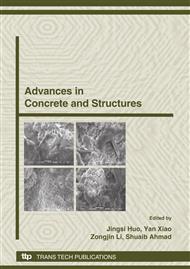p.519
p.525
p.531
p.537
p.543
p.551
p.559
p.567
p.575
Study on Crack Resistance of Steel Fiber Reinforced Self-Stressing Concrete in Old Bridge Reinforcement
Abstract:
Steel Fiber Reinforced Self-stressing Concrete (SFRSSC) is a new type of fiber reinforced composite material. It has various applications in civil engineering for its well known superior properties such as self-expansive performance and high tensile resistance. However, it is not widely accepted as an effective reinforcement in the rehabilitation of the old bridges at present. The primary goal of this research is to apply SFRSSC to improve the crack resistance in the negative bending moment areas of the old bridges. Firstly, a computer analysis on the internal force of the continuous T-beams with 5 spans is given in this paper. The results show that the expansive action of SFRSSC can effectively decrease the internal force in the negative bending moment area. Meanwhile, based on the experiments of 5 composite concrete inverted T-beams, the crack resistance of the beams reinforced with SFRSSC layers is investigated. The test results obviously indicated that the composite layers enhanced the cracking moments 44.9% more than conventional concrete layers, though its height is only 13.9% of the cross section height. It is concluded that the continuous beams strengthened by SFRSSC has greatly improved the crack resistance in negative bending moment areas compared with the continuous beams strengthened by conventional concrete. According to the existing theoretical models, a procedure how to determine the self-stress is supplied and a formula which evaluating the crack resistance of composite T-beams in negative moment area is deduced in order to supply references to the old bridge rehabilitation design.
Info:
Periodical:
Pages:
543-548
Citation:
Online since:
October 2008
Authors:
Price:
Сopyright:
© 2009 Trans Tech Publications Ltd. All Rights Reserved
Share:
Citation:


